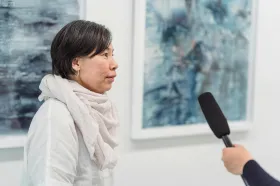Youth arts funding – quick links
In Creative Australia’s latest National Arts Participation Survey there is some interesting data on how much Australians – including teens and young people – value the arts in their lives.
The survey shows that on average, 84% of us readily acknowledge the positive contributions the arts makes to us and others in our communities.
But looking at the survey responses from the youngest age demographic in particular, those Australians aged 15 to 24 years, that jumps to a higher level, with 90% of this age group seeing the arts as having an important positive impact.
According to this Creative Australia research, the Gen Z cohort recognises the arts as having a ‘big’ or ’very big’ impact on their ability to express themselves, understand other people and develop new ideas.
Anyone who works in the arts would acknowledge these positive effects in a heartbeat. But it may surprise some to learn that the age demographic most willing to acknowledge the positive effects of arts and cultural activity is one of the youngest in our community.
Read: Canberra Youth Theatre tour explores fast food industry’s ‘disastrous consequences’
This leads to the question of why we have seen government funding for youth arts activities in continuous decline over the past decade.
There’s no shortage of policy documents and research studies that confirm the value of art programs for young people. (Creative Australia’s Next Generation Now report and A New Approach’s The Next Generation of Voters are just two examples.) And yet, the funding allocations for youth arts have been eroding over time.
How have we reached this low point in government support? Why isn’t the government willing to give youth arts organisations more funding attention when its policies and research prove their work has high value for this age demographic?
Another youth arts organisation bites the dust
Perhaps the most blatant example of the mismatch between messaging and action in youth arts space is the recent closure of youth arts peak body Propel Youth Arts WA.
Established in 2003 to provide young people aged 12 to 26 with platforms to engage with arts and culture, Propel was wound up earlier this year after its 2023 application for ongoing operational funding from the WA Department of Creative Industries was not supported.
At the time, Propel Arts WA’s then-Chair Helen Hristofski told ArtsHub the decision to close Propel was only made after exhaustive efforts to reduce its costs and diversify its income.
Speaking again to ArtsHub recently, Hristofski says she believes the WA Government’s decision to walk away from Propel is the latest in a long line of government funding decisions that have deprioritised youth arts and realigned it with small-scale, project-based funding programs, rather than providing sustained organisational support.
‘It’s definitely more difficult for youth arts companies in Australia to secure ongoing operational funding these days,’ she tells ArtsHub.
‘In funding terms, youth arts is not being valued in the same way as the main stage companies and those perceived as doing the important work,’ she adds. “As opposed to our work, which is seen as the “kids stuff”.’
Yet as multitudes of government policy documents show – documents which include the WA Department of Creative Industries’ own 10-year plan, Creative WA, that lists young people as one of the three priority demographics – the benefits associated with youth arts activities are vast and include positive social and mental health impacts.
Read: Why drama is the most important school subject
Hristofski says, ‘I don’t actually believe core youth arts funding should come from government sources like health or community services as opposed to arts and culture. But we know there are significant health and social benefits for young people as a result of their engagement in the arts.’
What Hristofski believes is most important right now is for government and other funding stakeholders to rebalance the frame, invest in children and youth arts as art first, and support it as a rigorous and imaginative art form like any other.
‘While we can recognise youth arts’ broader social dividends as evidence of its impact, those broader social benefits shouldn’t become its reason for being,’ she says.
‘Youth arts funding belongs in the arts portfolio, where imagination belongs. But that is not the message we are getting from government at the moment when youth arts core arts funding is shrinking or being pushed into other portfolios.’
Historic funding restructures limiting youth arts’ impact
While Propel Youth Arts WA has not survived, others in the youth arts sector are hanging on.
Artistic Director and CEO of St Martins Youth Arts Centre Nadja Kostich says that although her organisation is holding its own, like Hristofski, she has witnessed the erosion of organisational funding to the youth arts sector over time.
As Kostich tells ArtsHub, ‘At a federal level, the fact that for the past decade there has been no recognition of youth arts as an artform with its own funding program has meant we’ve lost a lot of companies who were making work with and for young people.’
She adds, ‘At St Martins, the only way we have been able to keep going is by attracting smaller amounts of money from a greater number of different sources – which is administratively costly and draining on our resources.’
Read: Arts students with disability faced harsh odds 40 years ago – what’s different now?
Kostich acknowledges Creative Australia’s reinstating of youth arts funding to some companies, but says the sector is yet to get back to where it was a decade ago.
‘We are definitely still devoid of some companies we lost over that time,’ she says.
‘What’s more, the funding landscape for youth arts-specific activities is much more challenging. The money that used to be there is simply not there anymore.’
Kostich also expresses concerns that government is encouraging awareness of subjects like social cohesion and community connectedness but is not following through with the funding to maintain programs – such as those in the youth arts space – that achieve proven positive impacts in those areas.
‘We have known for a long time that when young people are involved in activities like theatre-making, music-making and the performing arts it helps them learn how to work together, how to listen to each other and empathise, and how to negotiate,’ Kostich says.
‘If the government is recognising a particular need for these skills and qualities in the community, why isn’t it helping us deliver these programs that add value in those areas?’
Incoming social media ban will amplify value of youth arts
Robyn Jones, the Acting Chief Executive of long-running Adelaide-based youth arts organisation Carclew, also believes the government’s recent attention on issues like mental health, especially in relation to young people’s social media use, is a powerful argument for a shift in thinking around funding for youth arts.
While Carclew itself is in a fortunate position thanks to solid support from its State government, Jones is aware that many of her peer organisations are less secure.
‘We are very appreciative of the state government support we receive, but we can see that across the board there are great needs for better resourcing in the youth arts space,’ she tells ArtsHub.
‘In particular, I think we need to be mindful of the incoming teen social media ban in December this year which will present some immediate needs for young people to engage in socially nourishing, creative activities beyond their devices and screens,’ she continues.
‘In this context, where the government is responsibly aiming to guide young people’s engagement with certain online activities, it has the opportunity to provide enriching alternatives that support their development and wellbeing. Arts programs and activities can offer so much in this area.’
Youth arts activity needs arts funding
There is wide recognition within the youth arts sector that, now more than ever, young people are seeking creative outlets to express themselves and feel socially connected. (Our latest national surveys also support this.)
All three youth arts leaders interviewed for this story agree that now is not the time to devolve youth arts funding away from the arts and culture space.
Instead, Jones, Kostich and Hristofski argue that government must once again acknowledge the value of youth arts as an arts activity and service in and of itself.
‘Our main game is still about the art and art-making,’ Kostich comments.
‘Government must return to a position where it properly recognises the long-term benefits of meaningful arts experiences for young people, and reverses the declines in youth arts funding we have witnessed over the past decade.’






